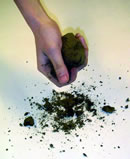Hamaoka nuclear reactors update

I have previously written about Japan Offspring Fund's campaign to raise awareness about the five nuclear reactors in Hamaoka, south of Tokyo.
Now, JOF notes that it doesn't take any strength at all to crush what Chubu Electric Power Company refers to as "solid rock". This is the kind of rock bed that the Hamaoka nuclear reactors are standing on. In case of the Tokai earthquake, the fact that the ground easily crumbles is a major concern.
Japan Offspring Fund, a NGO based in Kojimachi, Tokyo collected samples of rock at a distance of 100 meters from the actual site of the Hamaoka nuclear reactors, identical to the "solid rock" that the reactors are built on.
Read more here.
"Of all the places in all the world where no one in their right mind would build scores of nuclear power plants, Japan would be pretty near the top of the list." - Leuren Moret, who visited Japan in 2003.
The Japan Times: Japan's deadly game of nuclear roulette
Of all the places in all the world where no one in their right mind would build scores of nuclear power plants, Japan would be pretty near the top of the list.
The Japanese archipelago is located on the so-called Pacific Rim of Fire, a large active volcanic and tectonic zone ringing North and South America, Asia and island arcs in Southeast Asia. The major earthquakes and active volcanoes occurring there are caused by the westward movement of the Pacific tectonic plate and other plates leading to subduction under Asia.
Japan sits on top of four tectonic plates, at the edge of the subduction zone, and is in one of the most tectonically active regions of the world. It was extreme pressures and temperatures, resulting from the violent plate movements beneath the seafloor, that created the beautiful islands and volcanoes of Japan.
Hamaoka previous.

Comments